How to Choose Lenses?
Eyeglasses were first born in 1289 in Florence, Italy. It is said to have been invented by two inventors together, named Almato and Spina. And a more interesting invention is the progressive glasses, by American inventor Benjamin Franklin, who suffered from farsightedness and nearsightedness, invented the single-vision farsighted and nearsighted dual-purpose glasses in 1784.
The difference between spherical and aspheric

Spherical Lenses
In lenses with a spherical design, the aberration and deformation of increased, and the more spherical lenses to the edge of the degree, the result of the obvious image unclear, distorted vision, narrow field of vision, and other undesirable phenomena. Suitable for patients with mild myopia.
Aspheric Lenses
In aspheric design, aspheric lenses are equal in degree at each position, solving problems such as distorted vision, and, at the same time, making the lenses lighter, thinner, and flatter. Suitable for patients with medium to high myopia and astigmatism.
Material of Lenses
Glass Lenses
Higher clarity than resin, scratch resistant, good optical properties, but low usage rate, mainly for high lens index lenses, such as 1.8/1.9 lens index.
Resin Lenses
It is the most mainstream material, lightweight, high-temperature resistance, impact resistant, non-breakable, and effective in blocking ultraviolet rays, Eyesli lenses are all made of resin, so the choice of resin lenses already has an anti-scratch coating.
PC Lenses
It is also called "space piece", or "cosmic piece", has the advantage of being unbreakable and impact resistant, and is the lightest material used for lenses, but also the most expensive, so customers who need it can contact eyesli customer service for customization.
Choose the right lenses for your vision

Single Vision Distance
If you want to see objects at a distance, choose single-focus vision distance lenses to correct, that is, prescriptions corresponding to (-) to correct your vision correctly, and these lenses are concave lenses that are thin in the middle and thick around. Why is myopia, because not paying attention to the protection of vision, the eye axis grows abnormally, which eventually causes myopia to occur. The growth of the eye axis may accelerate after myopia, and if it is not controlled in time, it will increase the risk of eye diseases such as cataracts, glaucoma, and retinal detachment if it develops into high myopia over time. Therefore, it is especially important to prevent and control the development of myopia, especially the growth of the eye axis.
Reading Glasses
It is common to have difficulty reading at a distance after the age of 45, a physiological process that everyone must experience in their life. If you can't read the text on the computer at a normal working distance and unconsciously tilt your head back, you have to choose prescription (+) to correct your vision properly, and these lenses are convex lenses that are thick in the middle and thin all around.
Progressive Glasses
Our usual ordinary single-vision lenses, which usually have only one focal point, can only be used to see objects clearly at a single distance. The usual reading lens is a single vision positive lens that can be used to assist in seeing close at a certain distance, but when looking far away it is necessary to take off or change the glasses for seeing clearly at a distance.
Progressive lenses, on the other hand, have multiple focal points on one lens at the same time, allowing the wearer to see clearly at a distance, in the middle, and near through different viewing areas. There is no need to carry two pairs of glasses with you.
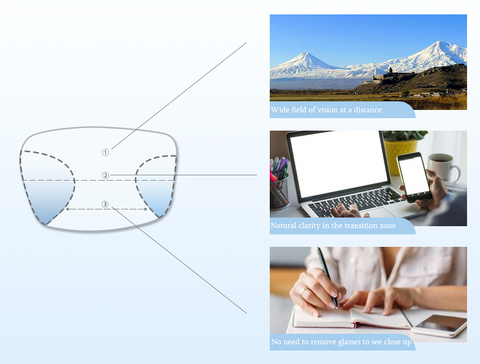
Lens Index
Lens index: also known as refractive index, its size can be used to measure the thickness of the lens, under certain conditions, as the refractive index increases, the thinner the lens, the more expensive.

Suitable prescription range
 |
For those with a slightly stronger prescription, these lenses may be a better choice than the 1.5 lens index. These lenses are thinner but more robust than 1.5 lens index lenses. 1.56 Index +/-0.00 - +/-4.00 |
 |
The birth of this refractive index can be said to be revolutionary, thanks to the Japanese Mitsui Chemical developed MR-8 material, material toughness and impact resistance is very good, suitable for all types of frame options, myopia is not more than 6.00 very recommended to use, the best overall performance! 1.61 Index +/-3.00 - +/-6.00 |
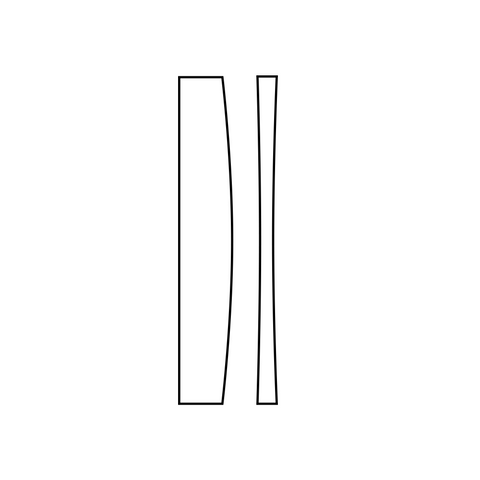 |
Material toughness and impact resistance are okay, you can do a frameless half-frame, Eyesli recommends this refractive index, especially Eyesli's products can choose! 1.67 Index +/-4.00 - +/-8.00 |
To sum up, if you are looking for visual effects and the prescription is not very high, then this is the recommended lens index.
1.61 index > 1.56 index > 1.67 index
If your prescription is +/-8.00 or +/-9.00 or even higher and you want thinner lenses, then the recommendations are.
1.61 index > 1.67 index
Functional Lenses
Anti-Blue Light
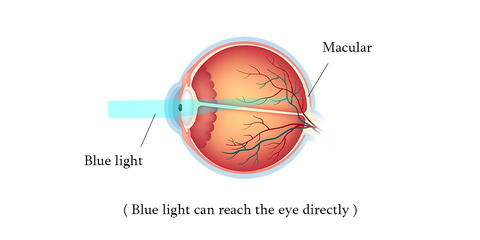
Nowadays, people work and live without computers and cell phones, with electronic products caused by visual fatigue, myopia, and other blue light hazards being increasingly prominent.
The blue light hazard refers to the blue light that can directly reach the fundus of the eye, and the photochemical effects caused by the irradiation can damage the retinal optic rod cells and the retinal pigment epithelium layer (RPE), which can produce age-related macular degeneration, resulting in impaired eye vision, dizziness, and dry and fatigued eyes. Anti-blue light lenses can effectively reduce the damage of blue light to the eyes, their role is mainly to reflect the harmful blue light or add an anti-blue light factor to absorb the harmful blue light, to achieve the blockage of blue light, and protect the eyes.
Photochromic Lenses

Photochromic lenses change color following the intensity of sunlight, and the color-changing factor in photochromic lenses absorbs ultraviolet light to achieve the color-changing effect.
As early as 1867, Fritsche observed the discoloration of tetraphenyl in the presence of air and light, and the resulting substance reverted to tetraphenyl when heated. Since the 1940s, a lot of research work has been done to clarify the mechanism of photochromism, the formation of intermediates, the causes of degradation, and the structure of products.
The color-changing lenses are UV absorbers by nature, and the difference in the UV protection effect of the different color-changing lenses is not great, but they all have their strengths and other functional characteristics.

Brown Lenses
Effective in improving visual contrast and clarity, better in air pollution or foggy conditions, ideal for drivers, mature people, and a higher number of patients.
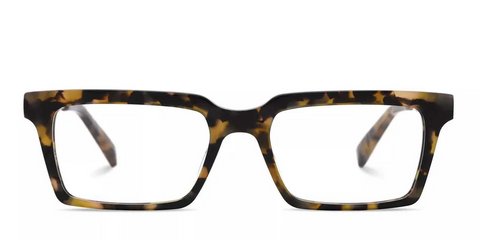
Gray Lenses
They can effectively reduce the intensity of light, have high color reproduction and are visually true, and are also neutral, suitable for all people.

Pink and Purple Lenses
They filter out stray light, soften the light by blocking glare, and can also play a role in relaxing and relieving stress. It is also a fashion tool for women's daily wear.

Blue Lenses
Can effectively absorb stray light in visible light, helping relieve visual fatigue. It is the preferred configuration for beach excursions.
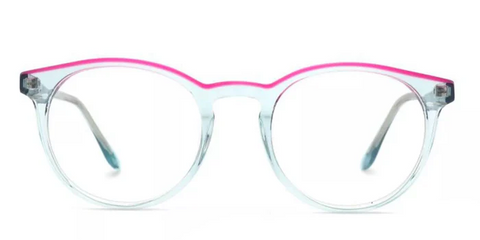
Yellow Lenses
Enhance visual contrast in the foggy environment and dusk environments, making vision clearer. Can be used as night vision goggles, especially suitable for driving people.

Green Lenses
And increase the green light reaching the eyes to relieve the stress caused by excessive use of eyes, suitable for people with visual fatigue.

Anti-Fatigue Lenses
Now phones and computers have become part of life, people spend most of their time in front of computers and cell phones whether it is for daily work or life: playing games, watching movies, looking for information, etc. Long time staring at the electronic screen at close range leads to more and more people having visual fatigue.
The general principle of progressive lenses is to add +50 ~ +60 degrees of adjustment load, optimize the myopic luminosity so that the microwave movement is back to normal, so that the adjustment system of glasses restores balance, to obtain the function of fatigue-free, to achieve a complete "decompression" for the eyes.
Polarized Lenses
In order to filter the sun shining on the water and other equal direction of the harsh light, adding special coating on the lens, most suitable for outdoor sports (such as fishing/ skiing/ sea activities)
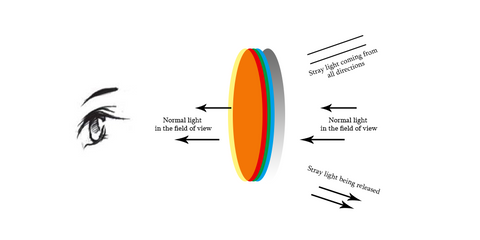
Lenses Coating
Anti-Reflective Coating
This lens is coated with a thin layer of magnesium fluoride on the surface of the lens to prevent strong light reflection so that you can see things more clearly and not be disturbed by strong light. In particular, the surface of myopic lenses is convex, so it is easy to reflect, especially when the light is through the lens surface, the lens will not only refract will also occur reflection, which brings some trouble to friends who like to take pictures. But if you add an anti-reflective coating to the lens, you can easily take a beautiful selfie.
How to check if your lenses have an anti-reflective coating?
Point your glasses at the light source, if you see purple or green reflections, it means there is an anti-reflective coating on the lenses.
Anti-UV Coating
Ultraviolet rays are divided into UVA, UVB, and UVC, and the main ones that can harm the human body are UVA and UVB. UVB causes "more and more redness" and UVA causes "more and more tanning". UV protection coating is divided into absorption coating and reflection coating, absorption coating is better for UV and infrared absorption. But absorption coating is the lens coating that absorbs the light, and becomes heat release, especially infrared, because of the heat build-up, which will make the eyes feel very uncomfortable. So anti-UV coating generally chooses reflective coating. If you buy eyesli lenses, you should know that they have built-in UV protection.
Anti-Water Coating
All eyeglass wearers are afraid of getting their glasses wet from rain or water. Water droplets can leave stains or dirt on your lenses, and cleaning them properly can be a pain - especially on rainy days. But there is a solution! A water-resistant coating prevents water droplets, dirt, and stains from getting on your lenses, which helps keep them clean and reduces the need for you to clean them regularly. Lenses with this premium coating stay crystal clear twice as long as regular glasses! If you live in a rainy area, work or live near a water source, or just like to be in and around water, we recommend you look into this lens coating to help keep your lenses as clear as possible!
Anti-Fog Coating
The anti-fog coating consists of a protective layer of titanium dioxide and a very thin nano-gold coating that absorbs infrared light to warm up the lenses, and by raising the temperature you stop water vapor from condensing on the lenses, and you are protected against fogging. When you enter an environment with heavy moisture or when you are camping outdoors in winter eating something hot can also keep your vision clear. If you have a long career in catering or need to wear a mask in the office, we suggest you look into this lens coating that can help you keep your lenses clear!
Anti-Scratch Coating
No one can guarantee that your lenses will not be subject to any impact, the anti-scratch coating will keep your lenses safe from daily wear and tear and enhance the resistance of your lenses to shocks. Eyesli's lenses include this feature for free to protect customers.









